Understanding One Carat Diamond Dimensions and Factors
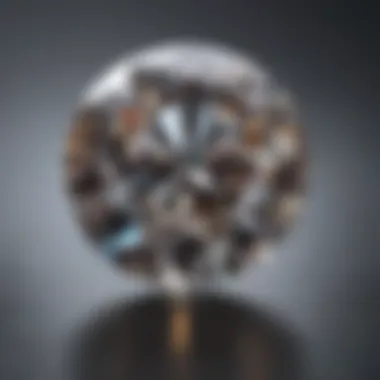
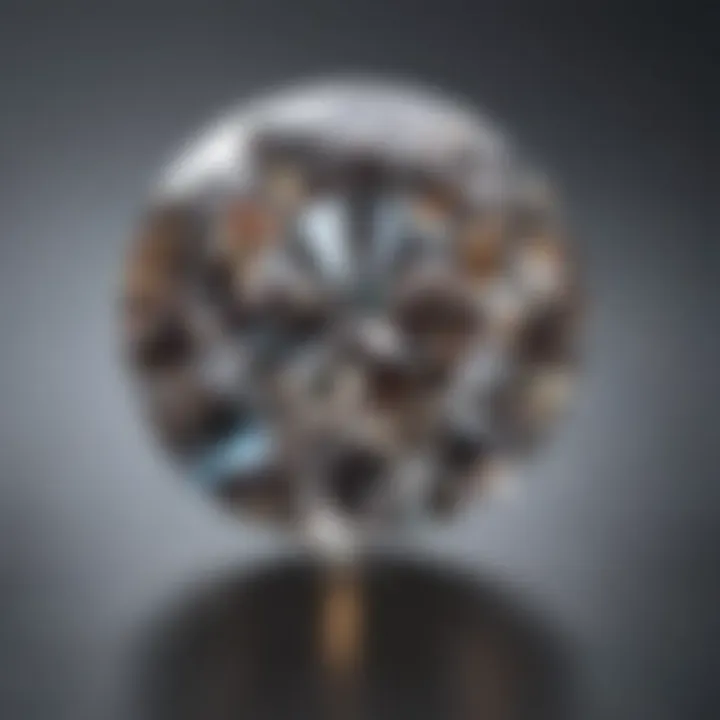
Intro
Gemstone Overview
Definition of Gemstones
Gemstones are precious or semi-precious minerals that are cut and polished to enhance their natural beauty. Among these, diamonds are unique. They are the hardest known natural material, largely prized for their brilliance and clarity. The term "carat" refers specifically to the weight of the diamond, with one carat equaling 200 milligrams.
Classification of Gemstones
Gemstones are classified based on several criteria. One major method of classification is by rarity and beauty. Diamonds, as gemstones, can be categorized into two types: natural and synthetic. Natural diamonds form over millions of years under extreme heat and pressure deep within the Earth. In contrast, synthetic diamonds are created in labs and possess the same chemical composition as their natural counterparts.
Additionally, gemstones are often classified by their color, clarity, cut, and carat weight, known collectively as the "Four Cs." Each of these factors plays a significant role in determining the diamond's value and perceived size.
Historical Significance
Origins of Gemstone Use
The use of gemstones dates back thousands of years. Throughout history, diamonds and other gems have held symbolic meanings, often associated with status, wealth, and power. In ancient civilizations, diamonds were frequently believed to possess protective qualities.
Cultural Insights: Gemstones in Ancient Civilizations
Several important cultures, including those in India and Rome, valued diamonds highly. In ancient India, diamonds were regarded as symbols of strength and were often used in ceremonial jewelry. In Rome, they were prized as tokens of affection and loyalty. Such historical significance has contributed to the allure of one carat diamonds in modern culture.
"Understanding the historical context of gemstones enhances not only appreciation but informs prospective buyers about their value and desirability."
The journey through the dimensions of a one carat diamond leads to an array of considerations. One must weigh factors such as cut, clarity, and color to truly appreciate what a one carat diamond can offer. This background sets the stage for a deeper exploration of these aspects.
Preamble to Carat Weight
Understanding carat weight is a critical aspect for anyone involved in the diamond market, whether for personal investment, collection, or design. Carat weight serves as a primary measurement that helps determine the value and price of diamonds. This section will explore the definition of carat and its historical context, highlighting how these concepts inform potential buyers about diamonds.
Definition of Carat
The term "carat" refers to the weight of a diamond and is a key factor in its valuation. One carat is equivalent to 200 milligrams. This unit of measure originated from the carob seeds used by traders in ancient times for weighing gemstones. Since these seeds were relatively uniform in size, they provided a standard for assessing weight. Over time, the carat became a globally accepted unit, standardized by the metric system.
Carat weight does not indicate the size of a diamond directly. For instance, two diamonds can weigh one carat but have different physical dimensions based on their cut. Popular belief often conflates weight with size, leading to common misconceptions during purchases. Proper understanding of carat weight will equip buyers with the knowledge necessary to make informed decisions.
Historical Context of Carat Measurement
Carat measurement has evolved significantly over centuries. The origins trace back to traders utilizing carob seeds as a counterbalance when weighing gemstones. This method was rudimentary and subject to inaccuracies, as the seeds could vary in size and quality.
In the 19th century, as gem trading expanded globally, the need for standardization grew. By the late 1800s, jewellers established the metric carat system of 200 milligrams. The introduction of the metric system provided consistency and reliability in trade. Today, the carat is universally recognized with little variation, ensuring buyers are not misled by fluctuating local practices. Understanding this historical context enriches the appreciation of diamond weight and serves as a foundation for evaluating gems in today’s market.
Physical Dimensions of a One Carat Diamond
The physical dimensions of a one carat diamond are essential in understanding its appearance and value. Measuring a diamond's size goes beyond just its weight; it is also about how the diamond interacts with light and how it is perceived visually. A one carat diamond can vary in size due to its cut, but typically, it measures around 6.5 millimeters in diameter. This measurement is crucial, as it significantly influences a diamond’s beauty and overall impact.
Understanding these dimensions helps buyers make informed choices. The preference for appearance over mere weight is important, especially for those considering their personal style and the settings they might use. Buyers should consider how a diamond looks on the finger or in a particular piece of jewelry, not just how much it weighs.
Typical Millimeter Size
The size of a one carat diamond generally falls between 6.1 to 6.5 millimeters in diameter for round cuts. This size is often perceived as ideal for engagement rings because it strikes a balance between notable presence and elegance. However, it is important to realize that not all diamonds of the same carat weight will appear identical in size. The actual dimensions can vary significantly based on the cut and shape of the diamond.
Here are some common dimensions for different cuts:
- Round Cut: Approximately 6.5 mm
- Princess Cut: Around 5.5 x 5.5 mm
- Emerald Cut: Roughly 7 x 5 mm
- Oval Cut: About 7 x 5 mm
These variations are important to note, as they will affect how the diamond is perceived by the viewer. When shopping for diamonds, potential buyers should ask jewelers about specific measurements to better understand how the diamond will look in real life.
Comparison with Other Carat Weights
When comparing a one carat diamond with different carat weights, the relationship between carat and visual size becomes apparent. For example, a two carat diamond may not appear exactly twice the size of a one carat diamond. Due to the way cut, depth, and width affect appearance, a heavier diamond may sometimes look only slightly larger.
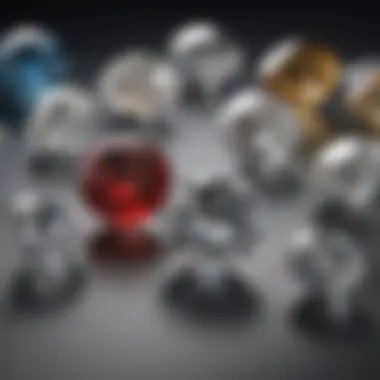
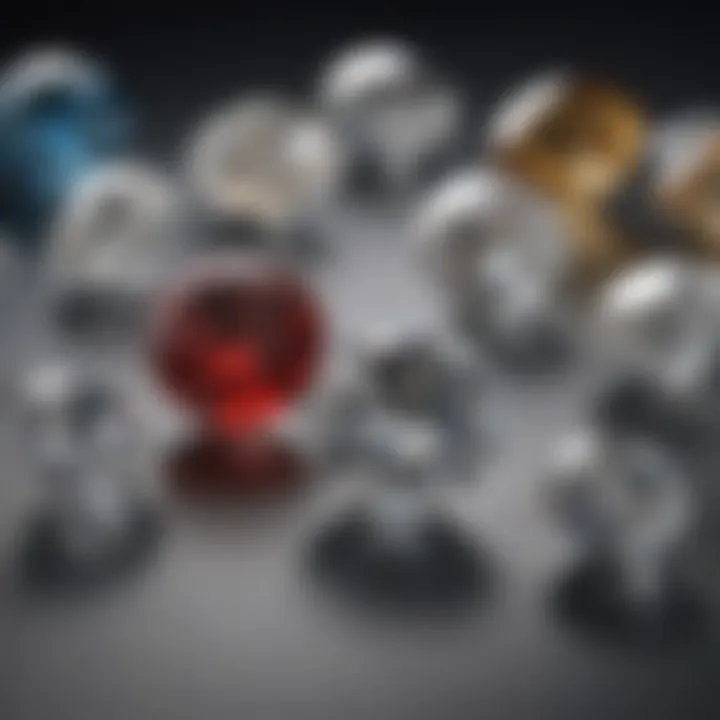
This is crucial for buyers who may be working with budget constraints or specific visual preferences. Here are some comparative insights:
- 0.5 Carat Diamond: This typically measures about 5.2 mm, appearing significantly smaller than a one carat diamond.
- 1.5 Carat Diamond: Expect about 7.4 mm in diameter, offering a more substantial look but coming at a higher price.
- 2 Carat Diamond: A two carat may measure approximately 8.2 mm, making it much more prominent than its one carat counterpart.
Buyers should not only focus on the carat weight itself but also on how the specific diamond compares visually in size. This understanding can guide them in selecting a diamond that satisfies both aesthetic desires and budgetary limits.
Factors Influencing Diamond Size Perception
The perception of a diamond's size goes beyond mere carat weight. Understanding the factors that influence this perception is essential for anyone considering the purchase of a one carat diamond. Various elements can modify how we see and value a diamond's dimensions, which can affect both the aesthetic and economic aspects of a purchase. This section will explore the role of cut quality, color, and clarity in determining the overall appearance of a diamond.
The Role of Cut Quality
The cut of a diamond refers to how well it has been shaped and faceted. This characteristic not only affects how light interacts with the stone but also greatly influences size perception. A well-cut diamond can appear larger than one that is poorly cut, even if both have the same carat weight.
- Cut grades, typically ranging from "Excellent" to "Poor", can have a significant impact on the overall look. Purchasing a higher-grade cut ensures that the diamond will reflect light optimized.
- It is essential to remember that the proportions of the cut impact the visual effect. For example, an ideal cut will maximize brilliance and fire, giving an illusion of greater size.
Investing in a well-cut diamond elevates its presence on the finger, making it seem more substantial without increasing the carat weight. Thus, when evaluating size perception, the importance of cut quality cannot be overstated.
Impact of Color and Clarity
Two other vital factors that influence how a diamond is perceived in terms of size are color and clarity. Both characteristics work in tandem to affect the visual impact of the gem.
- Color: Diamonds range from completely colorless to shades of yellow or brown. While color may not directly affect size, a colorless diamond often appears more brilliant, which can create an illusion of larger size.
- Clarity: This refers to the presence of internal or external imperfections, known as inclusions or blemishes. A clearer diamond is generally more appealing to the eye. Lower clarity can distract from the perceived size, as visible imperfections may draw attention away from the overall beauty.
The interaction of color and clarity deeply influences the aesthetic of the diamond, which in turn affects size perception significantly.
Shape Variations and Their Influences
The shape of a diamond plays a significant role in its overall appeal and perceived size. It affects how light interacts with the stone, influencing brilliance and sparkle. Different shapes can also have varying dimensions for the same carat weight, which is essential for consumers to consider when choosing a diamond. Understanding these variations helps buyers make informed decisions based on aesthetic preferences and budget constraints.
Round vs. Fancy Shapes
Round diamonds are the most popular choice, accounting for a substantial portion of diamond sales. Known for their classic appeal and unparalleled brilliance, they are designed to reflect light in specific ways that enhance their sparkle. Their standardized sizes make it easy for consumers to compare stones of the same carat weight.
In contrast, fancy shapes like princess, oval, and pear offer unique visual characteristics. These shapes can create an illusion of size, often appearing larger than their round counterparts. For instance, an oval diamond may look larger than a round diamond of the same carat weight due to its elongated shape. Buyers should take this into account based on their personal preferences. Here is a brief overview of common fancy shapes:
- Princess Cut: Square-shaped with sharp corners, known for its brilliance.
- Emerald Cut: Rectangular with step-like facets, emphasizing clarity.
- Asscher Cut: Similar to emerald, but square. It has a vintage appeal.
- Marquise Cut: Elongated shape that maximizes carat weight and appears larger.
Size Appearance in Various Cuts
The perceived size of a diamond can change significantly depending on its cut. Some cuts, although lower in carat weight, may look much larger due to their proportions and facets. For example, a well-cut marquise diamond can create an elongated look on the finger, making it appear more substantial than it actually is. Similarly, a cushion cut diamond might provide a square appearance that also contributes to a larger visual effect.
It's vital to recognize that depth and width ratios influence how large a diamond looks. Buyers should consider this when choosing a diamond, paying attention to the cut quality. A poorly cut diamond may not only look smaller, but it may also lack brilliance. Thus, selecting a diamond cut that aligns with both visual expectations and personal taste is crucial.
The choice of shape can greatly influence both the appearance and perception of a diamond's size, making it essential for buyers to understand these variations before purchase.
Common Misconceptions About One Carat Diamonds
When discussing diamonds, especially in the context of a one carat diamond, there are several misconceptions that frequently arise. Understanding these misconceptions is crucial for both buyers and enthusiasts alike. They can have a significant influence on purchasing decisions and overall satisfaction with the diamond selected.
Misunderstanding the way carat weight translates to physical size is a common problem. This can lead individuals to either overestimate or underestimate the value of a diamond based on its carat alone. Additional factors such as shape, cut, and the overall quality of the diamond often get overlooked.
A carat is a measure of weight, not size, which can confuse many. This leads to a skewed perception of how large a diamond truly looks on the finger.
Another notable misconception is the belief that higher carat weight inherently means a better diamond. This idea minimizes the importance of other qualities, such as clarity and color, which can significantly affect the diamond's beauty and can enhance its visual impact. Without recognizing the interplay of these factors, one risks purchasing a diamond that does not meet their expectations, despite a high carat weight.
Misunderstanding Carat vs. Size
It is essential to differentiate between carat weight and physical dimensions when discussing one carat diamonds. Carat weight measures the mass of the diamond, while size refers to how large the diamond appears when viewed.
A one carat diamond typically measures about 6.5 mm in diameter if it is cut in the round brilliant style. However, not all one carat diamonds appear the same due to variations in cut, depth, and proportions. For instance, an ideal cut may make a diamond appear larger than one that is cut poorly. This is because the light performance in well-cut diamonds results in an enhanced visual perception of size.
Some diamond shapes, such as oval or marquise, can give a larger appearance than round diamonds, even at the same carat weight. Thus, potential buyers should focus on both the carat weight and how these other factors affect the overall size and appearance.
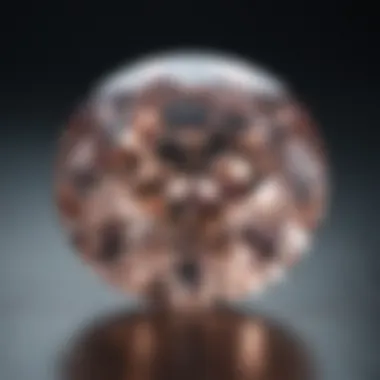
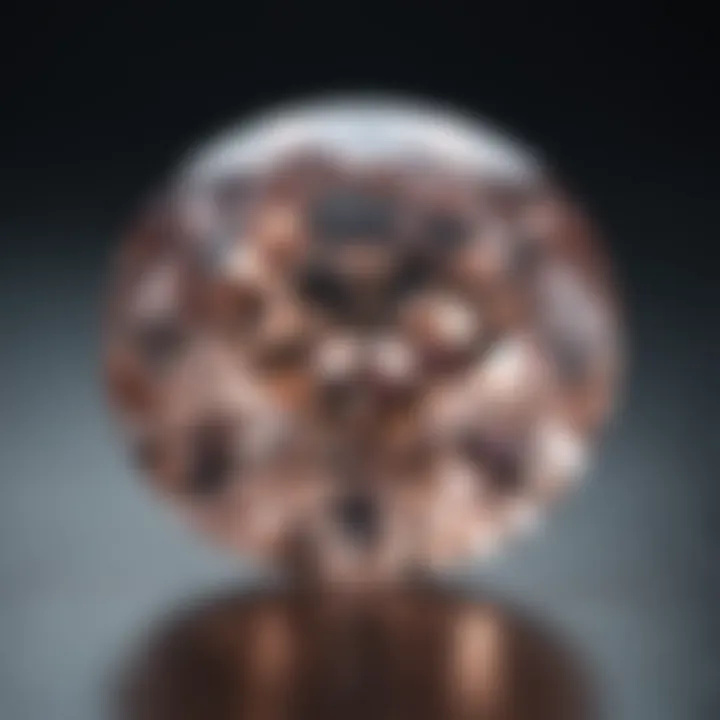
The Myths of Weight Alone
A prevalent myth in the diamond market is the assumption that weight alone results in desirability or value. While weight is a factor in the innate value of a diamond, it does not tell the full story. Several important aspects should be taken into account.
- Cut Quality: A diamond's cut can greatly influence its brilliance and overall appeal, potentially overshadowing carat weight in terms of beauty.
- Color: Higher color grades typically indicate more transparent and desirable stones, irrespective of carat weight.
- Clarity: Diamonds with fewer inclusions and better clarity may be more visually attractive, even at a lower carat weight.
Many people believe that just increasing carat weight makes for a better stone; however, this is not always the case. A diamond with poor cut, despite being heavier, may reflect light poorly and appear dull compared to a well-cut, lower carat diamond. Therefore, concentrating solely on weight can lead to disappointment after the purchase, indicating the need for well-rounded evaluation criteria.
Importance of Certification
When purchasing a one carat diamond, understanding its certification is crucial. Certification serves as a guarantee of the diamond's quality, providing a standardized assessment of its attributes. This will help buyers make informed decisions, avoiding potential pitfalls in the process.
Understanding Grading Reports
Grading reports detail the specific qualities of a diamond. They include essential information about attributes like cut, color, clarity, and carat weight. Each report is typically issued by a recognized grading organization such as the Gemological Institute of America (GIA) or the American Gem Society (AGS).
Key elements usually found in grading reports include:
- Cut: The quality of the diamond's facets, which affects its brilliance.
- Color: The presence of color in the diamond, rated from D (colorless) to Z (light yellow).
- Clarity: The presence of inclusions or blemishes within or on the surface of the diamond.
- Carat Weight: The weight of the diamond, which influences its size.
Having such data allows buyers to compare diamonds transparently and can help in identifying stones that offer the best value for their money.
It is important to note that not all grading reports are equal. Some organizations may have more stringent grading criteria than others. Thus, understanding the grading process offers deeper insights before committing to a purchase.
Reputation of Grading Organizations
The reputation of the grading organization plays a significant role when considering a diamond purchase. Not all certification bodies have the same level of credibility. Well-known institutions like the GIA or AGS are generally trusted more than lesser-known organizations because they adhere to rigorous testing and grading standards.
When choosing a diamond, buyers should consider:
- History of the organization: Longstanding organizations often have proven methodologies.
- Expertise of graders: Experienced gemologists provide a more accurate assessment.
- Acceptance in the industry: Diamonds graded by reputable organizations are recognized and valued more in the market.
In addition, consumers can access additional resources and discussions on these topics through platforms like reddit.com or facebook.com. These sources can offer insights into buyer experiences and satisfaction, which can be valuable when navigating the often complex world of diamond purchasing.
"Certification is not just a piece of paper; it forms the foundation of trust between buyers and sellers in the diamond market."
By prioritizing certification and leveraging grading reports, consumers can make well-informed choices that provide peace of mind and value over time.
Evaluating One Carat Diamonds for Purchase
Evaluating one carat diamonds prior to purchase is a crucial step for anyone looking to make an informed decision. This process goes beyond mere aesthetics, encompassing various aspects including quality, value, and the long-term implications of the investment. A one carat diamond is both a symbol of luxury and a significant monetary investment, making it essential to approach the evaluation methodically. Understanding the key elements that influence the evaluation helps consumers gain better insight into what they are purchasing and why certain diamonds capture more value than others.
Key Factors to Consider
When assessing a one carat diamond, several key factors emerge that significantly influence both price and appearance. First, it is important to consider the four Cs: cut, color, clarity, and carat weight itself. Each of these aspects combines to contribute to the overall beauty and value.
- Cut Quality: The cut determines how well a diamond reflects light, which directly affects its sparkle. Even if two diamonds appear to be the same in weight and size, their brilliance may vary greatly based on cut quality.
- Color Grade: Color in diamonds ranges from completely colorless (D) to light yellow or brown (Z). The less color a diamond has, the higher its value tends to be.
- Clarity Grade: Clarity refers to the presence of inclusions or blemishes. A diamond with fewer inclusions is generally considered more valuable.
- Carat Weight: While carat weight is important, it should not overshadow other factors. A well-cut .90 carat diamond may appear more beautiful than a poorly cut one carat stone.
A closer examination of these factors allows buyers to find the best combination that fits their preferences and budget.
Budgeting for a Quality Purchase
Budgeting effectively for a one carat diamond can significantly impact the purchase experience. It is essential to establish a clear budget before beginning the search. A realistic budget can guide the buyer through the complexities of diamond purchasing while ensuring they do not overspend.
- Determine Your Maximum Limit: Consider how much you are willing to spend. This should account for not just the diamond itself but also for any added costs such as jewelry settings, insurance, and future maintenance.
- Evaluate the Market: Prices for diamonds can vary widely based on market demand and availability. Understanding current market trends can help in setting a competitive budget.
- Explore Different Options: Prices can vary depending on the retailer, so shopping around at various outlets can reveal significant differences. Online retailers often have lower prices compared to brick-and-mortar stores.
- Consider Financing: If immediate payment is an issue, consider financing options. Many jewelers offer payment plans that can make a quality diamond more accessible.
Adhering to these budgeting strategies can lead to more satisfying outcomes when purchasing a one carat diamond.
Remember, the goal is not just to buy a diamond, but to invest in a piece that carries personal meaning and value over time.
Care and Maintenance of Diamonds
Caring for a diamond goes beyond mere aesthetics; it ensures the longevity of the jewel and helps maintain its brilliance over time. Proper care and maintenance can preserve a diamond's value and keep it looking its best. Given that diamonds are often treasured possessions, understanding how to protect and clean them is essential for any owner.
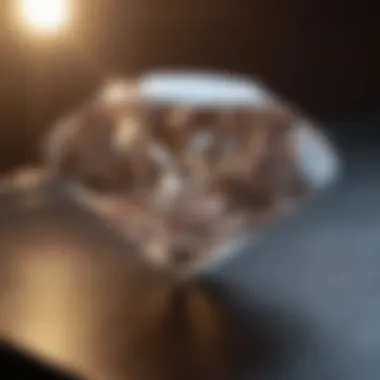
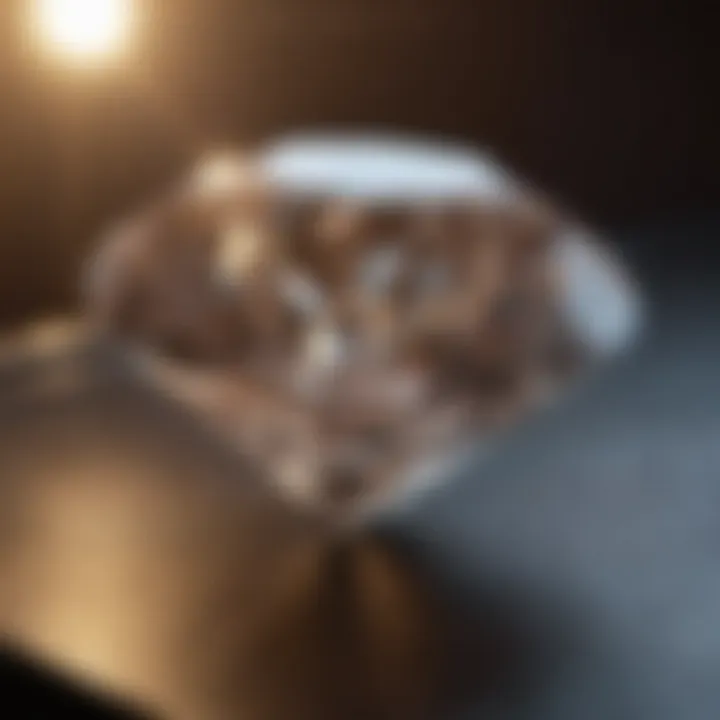
Cleaning Recommendations
Diamonds can accumulate dirt, oil, and grime from everyday wear. Regular cleaning is crucial for maintaining their sparkle. To safely clean a one carat diamond, consider the following methods:
- Soapy Water Soak: Mix a few drops of mild dish soap with warm water. Let the diamond soak for about 20–30 minutes. Then, use a soft-bristled toothbrush to gently scrub the stone, paying special attention to any crevices where dirt can collect.
- Ultrasonic Cleaners: These devices use high-frequency sound waves to gently clean diamonds and their settings. However, exercise caution if the diamond has any inclusions or is in delicate settings.
- Professional Cleaning: Consider taking the diamond to a certified jeweler for a professional cleaning solution every few years. Jewelers can access advanced cleaning techniques that a homeowner might not effectively use.
Preventative Measures for Longevity
Maintaining a diamond's brilliance isn’t only about cleaning; it's also about protection from damage. Here are several preventative measures to consider:
- Proper Storage: Store diamonds separately from other jewelry items to prevent scratching. A soft pouch or a dedicated jewelry box works best.
- Avoiding Harsh Chemicals: Chemicals in cleaning products, perfumes, and lotions can dull the shine of diamonds. It is advisable to put on jewelry after applying these products.
- Regular Inspections: Have the diamond checked periodically by a professional. They can assess the integrity of the setting and ensure that the diamond is secure.
By taking these steps, you can help ensure that your one carat diamond remains a stunning centerpiece for generations.
In summary, care and maintenance are vital components of owning a diamond. Cleaning regularly, storing them properly, and being mindful of external factors contribute to the diamond’s health and appearance. These practices enhance the perceived value and longevity of such an important item.
Cultural Significance of Diamonds
Diamonds hold a prominent position in various cultures around the world. Their significance goes beyond mere aesthetics; they symbolize wealth, commitment, and power. Understanding this cultural background enriches one’s appreciation for one carat diamonds and their enduring allure.
Their attributes, such as exceptional durability and rarity, contribute to the deep-rooted reverence seen across societies. In many cultures, diamonds are associated with love and devotion, often represented in engagement rings. This symbolism adds emotional value, turning the diamond into more than just a stone—it becomes a representation of a personal connection.
Also, the cultural significance of diamonds reflects societal norms and historical context. This can give insight into consumer behavior and trends in the diamond market. Recognizing these factors enables investors and buyers to make more informed decisions about their diamond purchases.
Symbolism Across Different Cultures
The symbolism of diamonds varies extensively among cultures. In Western societies, diamonds represent eternal love, particularly in the context of engagement and marriage. This tradition can be traced back to the 15th century when the Archduke Maximilian of Austria gave a diamond ring to Mary of Burgundy, the first recorded instance of this custom.
In cultures like Indian and Chinese, diamonds are seen as symbols of power and status. They represent wealth and prosperity, often reserved for royalty and nobility. The belief that diamonds have protective qualities is also prevalent. For example, in ancient cultures, they were thought to bring good luck and safeguard one from evil.
In Middle Eastern cultures, diamonds resonate with traditional values tied to family honor and loyalty. Giving a diamond is not merely a gift; it signifies a bond of trust and respect. Understanding these diverse meanings allows buyers to appreciate the deeper significance of their diamond purchases.
Evolution of Diamond Value in Society
The value of diamonds has evolved dramatically over the centuries. Initially, they were rare finds, prized for their chemical properties and unique physical characteristics. Over time, their desirability surged, influenced by marketing campaigns and cultural shifts.
During the 19th century, diamond mining became more extensive, primarily driven by discoveries in South Africa. This increased availability boosted societal perceptions of diamonds, establishing them as a standard in luxury goods.
In modern times, lab-grown diamonds have emerged as an alternative, challenging the traditional market. The perception of value is shifting, with some consumers prioritizing ethical sourcing and environmental considerations. This evolution reflects a broader trend towards sustainability in luxury goods, inviting discussions about the role of diamonds in contemporary consumption.
The ongoing changes in diamond valuation highlight the interplay between cultural significance and market dynamics. Buyers must navigate this landscape to understand both the emotional and financial investment involved in purchasing a one carat diamond.
"Understanding the cultural dimensions of diamonds is essential for any informed buyer. It adds layers of meaning to what may otherwise be viewed merely as a physical object."
Overall, recognizing the cultural significance of diamonds helps illustrate their timeless allure. This exploration serves to deepen appreciation and encourage knowledgeable purchasing in the world of one carat diamonds.
Future Trends in Diamond Buying
As the landscape of diamond acquisitions evolves, understanding future trends in diamond buying is crucial for buyers today. Awareness of these trends not only shapes purchasing decisions but also enhances appreciation for the diamonds themselves.
In recent years, consumer choices indicate a significant shift in preferences influenced by sustainability and ethical considerations. Many now prioritize lab-grown diamonds due to their lower environmental impact and ethical sourcing. These factors play a pivotal role in the decision-making process for a growing segment of buyers.
Influence of Lab-Grown Diamonds
Lab-grown diamonds are increasingly preferred, thanks to their affordability and ethical sourcing. These diamonds are chemically identical to natural stones but created in controlled environments. Their rise has sparked discussions about traditional mining methods and the environmental repercussions associated with diamond extraction.
Benefits of lab-grown diamonds include:
- Cost-effectiveness: They generally have lower price points compared to mined diamonds.
- Ethical Considerations: Lab-grown options eliminate concerns regarding conflict diamonds.
- Customization: Many manufacturers offer a range of options regarding size and cut, which can cater to individual tastes without substantial budgetary pressure.
Despite these advantages, some traditionalists remain skeptical about the value of lab-grown diamonds, often linking worth to the stone's origin. However, as awareness continues to grow, acceptance is increasing amongst consumers.
Emerging Consumer Preferences
Shifts in consumer preferences reflect broader societal changes. Current buyers tend to seek personalized products that align with their values. Factors influencing these choices include:
- Sustainability: More consumers expect brands to operate responsibly and transparently. Offering eco-friendly diamonds can match the growing demand for sustainable fashion.
- Unique Designs: There is a noticeable trend toward non-traditional cuts and settings. Buyers often prefer distinctive pieces that tell their unique stories.
- Technology Integration: The incorporation of online tools for virtual try-ons and simulations continues to become popular. Technology simplifies the purchasing process and enhances the consumer experience.
"The future of diamond buying lies not only in the carat weight or clarity but in the ethical and aesthetic stories that each piece can convey."



